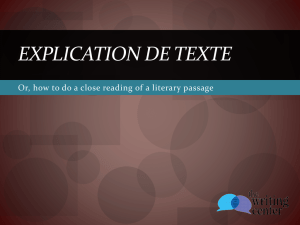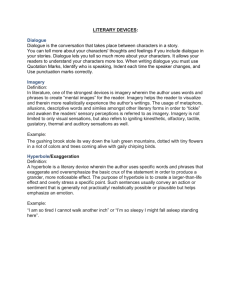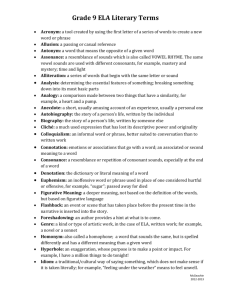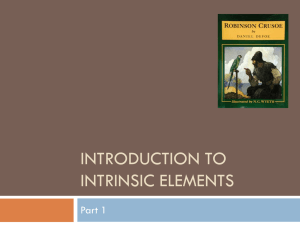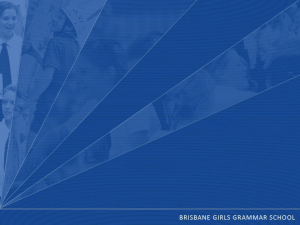Literary Terms - Solon City Schools
advertisement
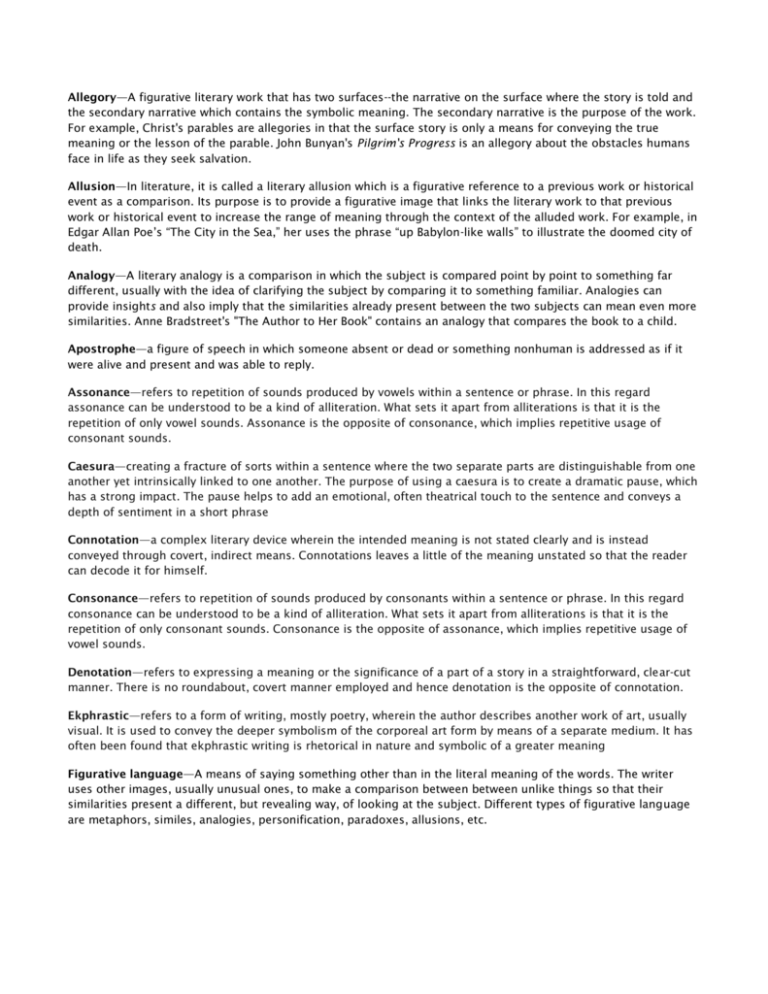
Allegory—A figurative literary work that has two surfaces--the narrative on the surface where the story is told and the secondary narrative which contains the symbolic meaning. The secondary narrative is the purpose of the work. For example, Christ's parables are allegories in that the surface story is only a means for conveying the true meaning or the lesson of the parable. John Bunyan's Pilgrim's Progress is an allegory about the obstacles humans face in life as they seek salvation. Allusion—In literature, it is called a literary allusion which is a figurative reference to a previous work or historical event as a comparison. Its purpose is to provide a figurative image that links the literary work to that previous work or historical event to increase the range of meaning through the context of the alluded work. For example, in Edgar Allan Poe’s “The City in the Sea,” her uses the phrase “up Babylon-like walls” to illustrate the doomed city of death. Analogy—A literary analogy is a comparison in which the subject is compared point by point to something far different, usually with the idea of clarifying the subject by comparing it to something familiar. Analogies can provide insights and also imply that the similarities already present between the two subjects can mean even more similarities. Anne Bradstreet's "The Author to Her Book" contains an analogy that compares the book to a child. Apostrophe—a figure of speech in which someone absent or dead or something nonhuman is addressed as if it were alive and present and was able to reply. Assonance—refers to repetition of sounds produced by vowels within a sentence or phrase. In this regard assonance can be understood to be a kind of alliteration. What sets it apart from alliterations is that it is the repetition of only vowel sounds. Assonance is the opposite of consonance, which implies repetitive usage of consonant sounds. Caesura—creating a fracture of sorts within a sentence where the two separate parts are distinguishable from one another yet intrinsically linked to one another. The purpose of using a caesura is to create a dramatic pause, which has a strong impact. The pause helps to add an emotional, often theatrical touch to the sentence and conveys a depth of sentiment in a short phrase Connotation—a complex literary device wherein the intended meaning is not stated clearly and is instead conveyed through covert, indirect means. Connotations leaves a little of the meaning unstated so that the reader can decode it for himself. Consonance—refers to repetition of sounds produced by consonants within a sentence or phrase. In this regard consonance can be understood to be a kind of alliteration. What sets it apart from alliterations is that it is the repetition of only consonant sounds. Consonance is the opposite of assonance, which implies repetitive usage of vowel sounds. Denotation—refers to expressing a meaning or the significance of a part of a story in a straightforward, clear-cut manner. There is no roundabout, covert manner employed and hence denotation is the opposite of connotation. Ekphrastic—refers to a form of writing, mostly poetry, wherein the author describes another work of art, usually visual. It is used to convey the deeper symbolism of the corporeal art form by means of a separate medium. It has often been found that ekphrastic writing is rhetorical in nature and symbolic of a greater meaning Figurative language—A means of saying something other than in the literal meaning of the words. The writer uses other images, usually unusual ones, to make a comparison between between unlike things so that their similarities present a different, but revealing way, of looking at the subject. Different types of figurative language are metaphors, similes, analogies, personification, paradoxes, allusions, etc. Hyperbole—a literary device wherein the author uses specific words and phrases that exaggerate and overemphasize the basic crux of the statement in order to produce a grander, more noticeable effect. The purpose of hyperbole is to create a larger-than-life effect and overly stress a specific point. Such sentences usually convey an action or sentiment that is generally not practically/ realistically possible or plausible but helps emphasize an emotion. Imagery—The author uses words and phrases to create “mental images” for the reader. Imagery helps the reader to visualize and therein more realistically experience the author’s writings. The usage of metaphors, allusions, descriptive words and similes amongst other literary forms in order to “tickle” and awaken the readers’ sensory perceptions is referred to as imagery. Imagery is not limited to only visual sensations, but also refers to igniting kinesthetic, olfactory, tactile, gustatory, thermal and auditory sensations as well. Juxtaposition—a literary device wherein the author places a person, concept, place, idea or theme parallel to another. The purpose of juxtaposing two directly/indirectly related entities close together in literature is to highlight the contrast between the two and compare them. This literary device is usually used for etching out a character in detail, creating suspense or lending a rhetorical effect. Metaphor—A comparison of two unlike things, as in “My boss is a dragon.” The purpose of the metaphor is to use the qualities of the one element to illustrate the qualities in the other. For example, in the above metaphor, the boss, by being compared to a dragon, is illustrated as someone who gets angry, destroys what is in front of her or him, and even hoards treasures. When reading poetry, look for such comparisons and interpret them according to what they have to say about the subject of the poem. Metaphor are never taken literally because to take them literally would create a nonsensical image. Onomatopoeia--refers to words whose very sound is very close to the sound they are meant to depict. In other words, it refers to sound words whose pronunciation to the actual sound/noise they represent. Personification—one of the most commonly used and recognized literary devices. It refers to the practice of attaching human traits and characteristics with inanimate objects, phenomena and animals. Rhyme Scheme—The practice of rhyming words placed at the end of the lines in the prose/ poetry. Rhyme scheme refers to the order in which particular words rhyme. If the alternate words rhyme, it is an “a-b-a-b” rhyme scheme, which means “a” is the rhyme for the lines 1 and 3 and “b” is the rhyme affected in the lines 2 and 4. Simile—Comparing two unlike things (usually nouns) by using or implying like or as. For example, Emily Dickinson uses a simile in Poem 1263 when she says, "There is no Frigate like a Book." The purpose is the same as with all tropes (see below) in that the comparison must be taken figuratively and never literally. In Dickinson's poem, she is comparing a book (the subject of a poem) to a frigate to indicate that the book, like a frigate, can carry a person away. Theme—The base topic or focus that acts as a foundation for the entire literary piece. The theme links all aspects of the literary work with one another and is basically the main subject. The theme can be an enduring pattern or motif throughout the literary work, occurring in a complex, long winding manner or it can be short and succinct and provide a certain insight into the story. Tone—The perspective or attitude that the author adopts with regards to a specific character, place or development. Tone can portray a variety of emotions ranging from solemn, grave, and critical to witty, wry and humorous. Tone helps the reader ascertain the writer’s feelings towards a particular topic and this in turn influences the reader’s understanding of the story.

